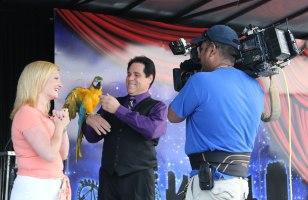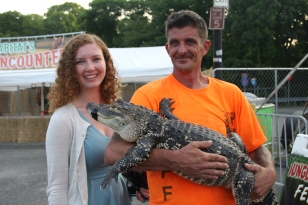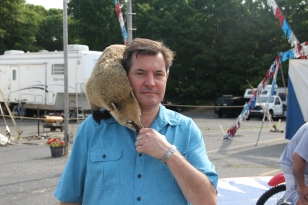During my career I have worked with the many local New York area media outlets. I have been involved with over 250 live morning TV news remotes. Each of these mornings included at least several segments featuring clients and causes which I support. Segments have taken place at locations across the entire New York region including Long Island, Queens, Manhattan, Brooklyn, The Bronx and lower Connecticut.
Each morning remote is different because of the client, message and location. However, the one aspect that doesn’t change is the amount of planning and preparation that is involved.
In order to ensure live TV coverage works, you must approach the media well in advance with a special, original and visually intriguing story. You must know all the details regarding exactly when and where the media would be able to cover the story and describe the visuals and location.
Here is a recent example of what goes into this effort and the challenges: earlier this summer, the Brookhaven Fair was on Long Island. I contacted local cable news network News 12 Long Island early and provided the dates that the fair was taking place. I have worked with the Brookhaven Fair for over a decade and knew that News 12 was an outlet that had done live mornings at fairs in the past. I was hopeful that they would be interested again, but it is never a sure thing. I communicated with the show producers and was able to get a date set up.
The early morning live coverage morning at the fair meant that the reporter and news truck would be arriving before 5 a.m. to set up their trucks and equipment. I visited the site the day before to assess the layout of the location and make sure there was a centrally located area for the truck to park.
The truck must be centrally positioned to cover each segment that was planned. The location should also take into account the ability to send and receive a broadcast signal and quickly run cables to each new position. I recommend doing a site visit before the news outlet arrives because it is also a chance to talk to everyone who will be interviewed. In my case, I was able to give them details and let them know how the morning will work. It is going to be early so I knew that they would be better off if they were prepared ahead of time. It is very hard to do this in a rush at 5 a.m.
Often people being interviewed do not have experience being on live television so it is important to recognize this and outline the process for them; give them sample questions or talking points so they can prepare their answers for the interview and run through any movements or interactions with animals, people, or surroundings to ensure they are providing the best visual and message for the audience. Live television segments in the early morning may only be one to two minutes long, so the preparation beforehand will eliminate any wasted coverage due to confusion of what to do or say during the short interview. For this particular morning at the fair, it was easier because each performer was describing what they do.
Although I did on-site visits, confirmed the night before with everyone and had constant communication with the media and people at the fair, we did have a last minute cancellation due to breaking news. This is another aspect that you must be prepared for in advance; breaking news, bad weather, injuries or any other interruption can occur at any moment and you must have a protocol in place in case it does happen. In this situation, I received a phone call at 3 a.m. informing me that the morning shot had been replaced by breaking news. I had to immediately contact everyone at the fair and tell them. In the end it worked out well; the fair was in town for another week, so we were able to provide an alternative date. We were lucky, often you only have one shot.
The planning should continue all throughout the morning of the remote. Always be in constant communication with the studio, providing them with the information about location, set up, names of people to be interviewed and the visuals they will be able to receive at certain times. For example, some of the performers at this fair including the team from the Fearless Flores Thrill Show and their motorcycles could only be used in later segments because of the lighting and potential for moisture. Their act includes the “Globe of Death” and motorcycles need to run on dry surfaces to be safe. With this in mind, we planned out the entire morning.
Even with all the planning and preparation, always be ready to react if something were to go wrong. There is limited time for hesitation. At the fair, we were dealing with animals in some segments and they are not predictable. We also had to manage the loud noise from the motorcycles that prevented the interviewer from asking questions or hearing comments from guests. However, we were able to make adjustments and the segments looked great. For each segment we go through what will be done and who will be speaking. Everyone is well prepared and they understood what they had to do and what the TV crew needed.
Along with organizing each segment and performer, I worked in between the segments to share and post video and pictures of the fair and media to spark more interactions with our audience. I used Meerkat on my iPhone and was able to live stream the activity and provide commentary which increased traffic and interest in the fair. Live tweeting and streaming is mutually beneficial; it brings attention to your client and activity as well as you and your brand. Thousands of people saw the posts and many commented. Many also attended the fair that weekend.
Coverage does not have to end once the media outlet finishes their live segments. After sharing your pictures and video throughout the morning, continue to share throughout the day, and in the case of the fair, throughout the weekend. People are interested in seeing what happens behind the scenes during live TV events, so they will appreciate seeing the updates on your social media accounts and be more likely to visit your client’s website, attend the event and remember their brand which is the whole reason for obtaining this coverage to begin with. I always share pictures with reporters who use them on their social media sites. These activities help get the message out to more people and it creates a personal connection with those involved.
Live morning television takes time, energy and planning. The day can start early; sometimes midnight, 1 a.m. or 2 a.m. A typical live remote will include three to eight segments. These segments are typically two to three minutes in length. The value of this coverage is significant and long lasting. Morning coverage is on when people are getting ready for work and school. They are looking at the news of the day, weather and sports; early morning is “prime time” for many viewers.
By Bill Corbett
Corbett Public Relations Long Island and the World
Filed under: live, television | Tagged: communications planning, live, television |










[…] More than one million people have attended the events that we have promoted. In July I wrote about what it’s like to do live morning TV. One memory related to the Nassau Coliseum Fair stands out. This particular fair took place in July […]
LikeLike